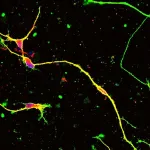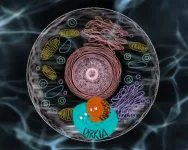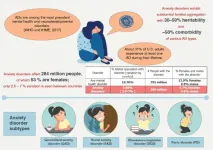(Press-News.org)
Researchers at UNIL’s Department of Ecology and Evolution reveal the existence of social traditions in vervet monkeys. This work was published in iScience on December 19, 2023.
British tits have learned from each other how to pierce the lids of milk bottles left on doorsteps. On the island of Koshima, Japanese macaques started washing sweet potatoes to rid them of sand. The animal realm is full of examples of traditions linked to food, tool use or hunting techniques that have spread within specific communities. However, few traditions of social nature, i.e. how individuals interact with each other, have been described.
A study led by Erica van de Waal, Associate Professor in the Department of Ecology and Evolution (DEE) at UNIL's Faculty of Biology and Medicine, and Charlotte Canteloup, a former DEE post-doctoral fellow, documents the existence of socially transmitted customs in three groups of vervet monkeys from the same population.
Erica van de Waal's team has been studying the cognitive and social abilities of these primates for almost fifteen years, as part of the "iNkawu Vervet Project" initiated by the professor. In the field, in South Africa, biologists follow these animals daily, identifying each one, observing them and recording their behaviours. These can be affiliative (so-called "positive" social attitudes), such as time spent sitting side by side or playing together, body contact and grooming. Or agonistic, such as conflicts, threats or aggression.
Genetics and environment out of the equation
First author of the study, Elena Kerjean a former master's student under the supervision of Erica van de Waal and Charlotte Canteloup, analysed 84,702 social interactions involving 247 monkeys between 2012 and 2020. She then calculated a sociality index estimating the propensity of individuals to be rather affiliative or agonistic, an index measuring the reciprocity of grooming and an index quantifying social behaviours between members of the same family.
"The results show that one of the three groups, called AK, was generally more affiliative than the other two, and that grooming was more reciprocal. This was true throughout the nine years of the study", says Charlotte Canteloup, now a permanent researcher at the CNRS and the University of Strasbourg. This observation was independent of socio-demographic variations between the three groups, including sex ratio, number and age of individuals. "Furthermore, as the three groups share a very similar habitat with overlapping territories, and gene flow is ensured by the movement of males between groups, it is highly improbable that these variations in sociality can be explained by ecological and genetic differences only. All this suggests a social origin for these differences", adds Elena Kerjean.
According to the researchers, AK members may have developed a more affiliative "social tradition", under the social influence of the community or specific key individuals. "The monkeys could thus behave like others through a process of behavioural mimicry acting like a social glue", suggests Charlotte Canteloup.
Males embrace their new home’s habits
Interestingly and surprisingly, according to the authors, some animals - in this case six adult males who dispersed to their neighbour groups - adapted their behaviour to match that of their new home. Thus, those who left the most social group to join one of the other two became less social. And vice versa.
In a previous study, the team looked at how a new eating habit spreads and is maintained in vervet monkeys. "We had found that males abandoned their initial preference for one food and conformed to the local dietary norm of their new community. This time, we show that this conformity may extend to social behaviour, which has never been reported before", comments Erica van de Waal.
More generally, the research published in iScience contributes to a better understanding of the traditions of vervet monkeys in their natural habitat, which are far less studied and documented than those of great apes such as chimpanzees. "Primate cultures are made up of a greater variety of customs than what was believed even a few years ago. The more research progresses, the more we discover that 'basic' and universal social behaviours in apes, such as play, body contact and grooming, form the basis of cultures", concludes Charlotte Canteloup.
Links:
Erica van de Waal's group
Erica van de Waal’s profil (French)
INkawu Vervet Project END
WASHINGTON, Dec. 19, 2023 – A winter wonderland calls to mind piles of fluffy, glistening snow. But to reach the ground, snowflakes are swept into the turbulent atmosphere, swirling through the air instead of plummeting directly to the ground.
The path of precipitation is complex but important to more than just skiers assessing the potential powder on their alpine vacation or school children hoping for a snow day. Determining snowflake fall speed is crucial for predicting weather patterns and measuring climate ...
AI models in health care are a double-edged sword, with models improving diagnostic decisions for some demographics, but worsening decisions for others when the model has absorbed biased medical data.
Given the very real life and death risks of clinical decision-making, researchers and policymakers are taking steps to ensure AI models are safe, secure and trustworthy—and that their use will lead to improved outcomes.
The U.S. Food and Drug Administration has oversight of software powered by AI and machine learning used in health care and has issued guidance for developers. This includes a call to ensure the ...
About The Study: Although standard artificial intelligence (AI) models improve diagnostic accuracy, systematically biased AI models reduced diagnostic accuracy, and commonly used image-based AI model explanations did not mitigate this harmful effect in this multicenter randomized clinical vignette survey study involving hospitalist physicians, nurse practitioners, and physician assistants from 13 states.
Authors: Michael W. Sjoding, M.D., of the University of Michigan Medical School, and Jenna Wiens, Ph.D., of the University of Michigan, Ann Arbor, are the corresponding authors.
To ...
About The Study: In this study of 13,000 patients, few patients undergoing surgical procedures completed preoperative life-sustaining treatment documentation, with disparities in documentation rates based on race, ethnicity, rurality of patient residence, history of mental health disability, and access to high-volume facilities within a Veterans Affairs cohort.
Authors: Adela Wu, M.D., of the U.S. Department of Veterans Affairs, in Palo Alto, California is the corresponding author.
To access the embargoed study: Visit our For The Media website at this link https://media.jamanetwork.com/
(doi: ...
About The Study: This study found that patients screened in the emergency department (ED) were more likely to screen positive for Social Determinants of Health (SDOH) needs, which is not surprising given utilization patterns. Patients with SDOH needs have limited health care access and are more likely to use the ED than primary care. Although primary care–based screening found lower SDOH needs relative to the ED, primary care may be better optimized to follow and ultimately address SDOH needs.
Authors: Stacie ...
Humans have wiped out around 1,400 bird species – twice as many as previously thought – with major implications for the ongoing biodiversity crisis, a new study has found.
Many of the world’s islands were previously untouched paradises, but the arrival of people to places like Hawaii, Tonga and the Azores led, over time, to far-reaching impacts including deforestation, overhunting and the introduction of invasive species. Consequently, bird species were wiped out.
While the demise of many birds since the 1500s has been recorded, our knowledge of the fate of species before this relies on fossils, ...
Researchers from Tokyo Medical and Dental University (TMDU) develop a genome-editing technique that reduces disease-causing proteins and related issues in cells from a patient with Charcot–Marie–Tooth disease type 1A
Tokyo, Japan – Scientific advances in the last century have changed our world significantly. For example, the world of genetics has opened doors to a myriad of possibilities: augmented human capabilities, cures for diseases, and even changes to the course of evolution.
In a study published last month in Communications Medicine, researchers from Tokyo Medical and Dental University (TMDU) have unveiled a groundbreaking genome-editing technique. This ...
Kyoto, Japan -- Down syndrome, a congenital disorder stemming from abnormal cell division and differentiation, is most common in newborns fated to neurodevelopmental delays and other health complications.
The genetic defect causes the dysfunction of the protein kinase DYRK1A, which is encoded on chromosome 21 and is deeply associated with both Down syndrome and autism spectrum disorder. DYRK1A has attracted attention as a target molecule for treating various diseases, but specific cellular mechanisms regulating ...
Kyoto, Japan – December 2023
Anxiety disorders (ADs) affect more than 280 million people worldwide, making them one of the most common mental health conditions. ADs have a genetic basis as seen from inheritance in families, and people with one subtype of AD tend to have another subtype, suggesting a shared genetic basis. Although the brain circuitry involved in ADs has been identified, its link with gene expression remains unclear. Two researchers at Kyoto University in Japan set out to uncover this link and found two gene clusters expressed in ...
Using a novel experimental approach, Max Planck researchers have discovered a core set of genes required by commensal bacteria to colonize their plant hosts. The findings may have broad relevance for understanding how bacteria establish successful host–commensal relationships.
Plants are colonized by an enormous variety of microorganisms, including bacteria, archaea and fungi, that form complex communities, or microbiomes, on their roots and organs. Although invisible to the naked eye, the importance of these tiny inhabitants should not be underestimated. They play a crucial role in plant nutrition, influence the health of plants, strengthen their tolerance to stress factors such as ...




